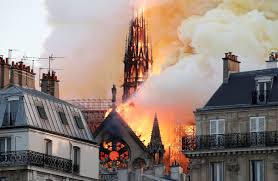Notre de Dame, one of the most notable historical monuments has immortalized Gothic architecture and has been the center of French cultural heritage for years.
On April 15, 2019, a fire broke out at Notre Dame Cathedral, Paris engulfing almost a major portion of the 850-year-old iconic church.
The blaze lasted for several hours destroying the historical spire and roof portions until it was successfully contained by firefighters on Tuesday morning.
Some of the artifacts, relics including the “Crown of Thorns” and a pair of bell towers survived the dreadful fire.
The cause of the fire remains unknown and the officials have ruled out any foul play as of now.
Reports claim that no lives have been lost which is a relief. However, two firefighters have been injured in the line of duty.

History of Notre Dame de Paris Cathedral
Contents
Notre-Dame Cathedral is located in the island of Lle de la Cite Island in the middle of River Seine in Paris, France and is a landmark in European history.
The Catholic Church is a magnificent example of gothic architecture and is a major source of attraction for its historical events, distant past, and architectural marvel.
Notre-Dame Cathedral history dates back to the early 12th century and was built on the ruins of two earlier churches.
The cathedral has been built over a period of 200 years and is undergoing renovations ever since.
Notre-Dame meaning “Our Lady of Paris” known for its architectural brilliance is the seat of Archbishop of Paris.
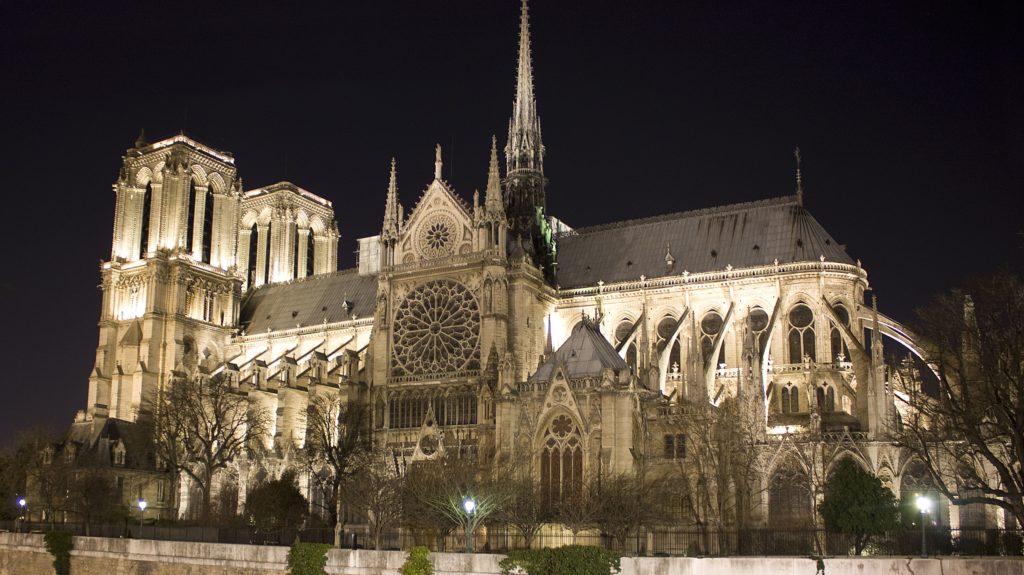
The Beginning of Notre-Dame Cathedral
The first construction of Notre-Dame started during the reign of King Philip I and continued with King Louis VII’s monarchy.
The Lle de la Cite was the center of economic development and urban constructions in Paris and many renowned architects and craftsmen resided near the River Seine.
It was Maurice de Sully, the Bishop of Paris (1160-1196) who took the initiative to construct a new Cathedral to replace the older Saint Stephen Church just 40 meters away from the Notre-Dame Cathedral.
The idea was to create a new-age cathedral based on modern architectural techniques and the French-Gothic style that was in rage during those times.
So, the Saint Stephen Church was demolished to create a way for a new square and the 6-meter wide street named Rue Neuve-Notre-Dame to provide easy access to the cathedral.
It is believed that Pope Alexander III laid down the first foundation stone of Notre-Dame in 1163 and the construction of the historical church began.
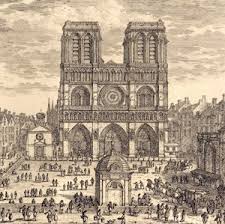
Notre de Dame Architecture
Notre de Dame is a living example of Gothic sculpture and the particular use of stained glass is a marked improvement from early Romanesque architecture.
During the early 13th century, the construction started with the erection of the choir and the aisles behind the altar.
Henri de Chateau-Marcay the Papal Legate along with Maurice de Sully commissioned the choir’s high altar.
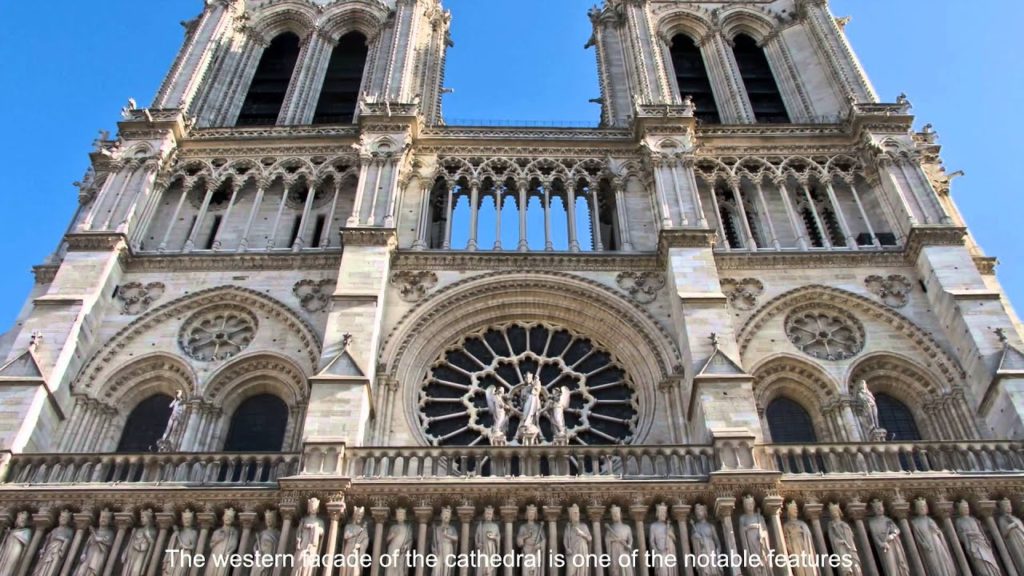
The Western Facade
By the end of 1225, the western façade with a large rose at the center and two statues of Adam and Eve were constructed.
By 1250, the North and South Towers were constructed and the Cathedral was very tall and required additional support. Flying arch buttresses were designed to give support and push the wall outwards.
The first window known as the North Rose window was constructed in 1250. It is 12.9 meters in diameters and features the portrait of Mother Mary holding a child in her hands.
Master Mason Jean de Chelles laid down the first stone in 1258 on southern façade and the Southern Rose window was constructed which was 13.1 meter in diameter and 19 meter in height. It was a gift from King St. Louis and consists of 84 panes dedicated to the New Testament.
One of the architectural brilliance was the use of stained glass in windows which was an exemplary symbol of gothic art. The stained glasses let in more light and were painted with ancient biblical arts based on Christian beliefs which motivated the congregation.
On the western façade, which was 41 meters wide and 63 meters wide under the balustrade there lies the “Galley of kings” with 28 different statues symbolizing the “Kings of Judah” symbolizing the forefathers of Jesus and Mary.
At the center of the western façade, lies the statue of the Virgin Mary with a child and on each side there stands two angels.
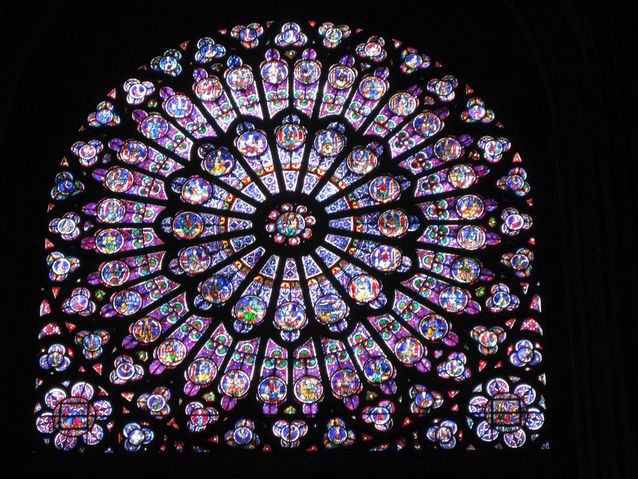
The Flying Buttresses
Notre Dame was actually the first building ever to incorporate the 4 tall flying buttresses standing harmoniously at the top of the towers symbolizing that the cathedral is built for God.
The buttresses were meant to support exterior walls. The walls were crafted and statues and Gargoyles as water spouts were erected to provide column support.
The frame of the Notre de Dame is made of oak trees which is 100 m long and 13 m wide. The frame supports a lead roof weighing around 210 tons.
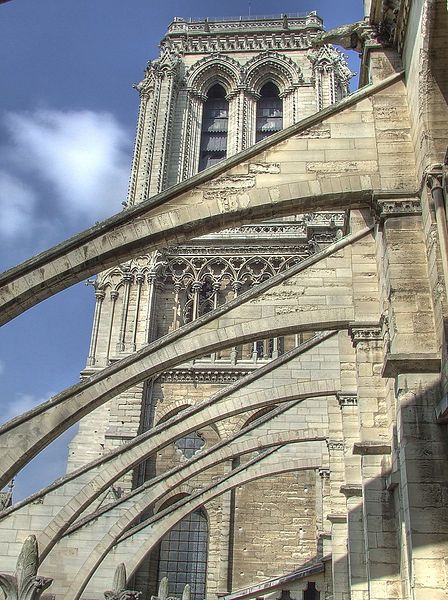
Portals of Notre Dame
At the entrance lies the “Portal of the Last Judgement” an ornamental structure consisting of lintel and arch.
The lower lintel consists of figures resembling dead being revived. The upper lintel consists of archangel Michael carrying their souls. The frame also shows followers of God marching towards heaven on the left and the ones condemned are led to the hell on the right.
At the middle, sits Jesus majestically on his throne of glory. On the archivolts, there is a beautiful depiction of heavenly figures, angels and virgins.
The Saint Anne Portal, the oldest of the three depicts the sculpture of the Virgin Mary with a child. She is sitting peacefully in her throne guarded by angels with Bishop of Paris on the right and King of France to her left. On the background, there are wedding scenes of Mary and Joseph and also the arrival of Christ on Epiphany.
The third portal symbolizes the death of the Virgin Mary and her departure to heavens. The portal shows Mary on her deathbed surrounded by 3 Prophets of the Old Testament.

The Organs
There are three organs in Notre-Dame. One of them is the largest in France consisting of 8000 pipes and 5 keyboards.
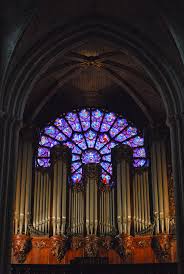
The Spire
Notre-Dame’s original spire representing a bell tower was taken down and was replaced by a new one built during Viollet-le-Duc’s restoration phase. It consisted of 12 copper statues.

Bells of Notre de Cathedral
Before the French Revolution, there were about 20 bells of which only Emmanuel, the 13-ton bell was spared and still stands today as a historical monument.
The Red Door
Porte Rouge or the Red Door named after its color was built around 1250. At the base of the door is a sculpture of King St. Louis with his wife Marguerite of Provence. The door carries scenes from the coronation of Mother Mary and the life of St. Marcel.
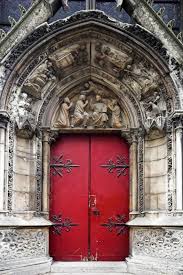
The Cathedral Square- Parvis Notre Dame
Cathedral Square is the center of all events, festivities, religious and cultural ceremonies, thanksgiving, and conferences.
In 2012, major restoration work was done which included the construction of 9 new bells, cathedral treasury, restoration of Statue of St. Geneviève, Grand organ, and indoor lighting.

The Symbolism of Notre Dame Cathedral
Notre de Dame is a symbol of French cultural heritage. Despite the numerous renovations the cathedral includes several structures that give us a glimpse of its ancient history and architecture.
Notre Dame holds several early Christian relics like the “Crown of Thorns” which was believed to be the crown that was placed on Jesus’s head before his crucifixion.
The cathedral has endured a lot over the years and is, in fact, a symbol of Paris’s rich political and intellectual culture.
Notre Dame is known as “Our Lady of Paris”, which was a tribute to Virgin Mary, mother of Jesus.
Notre-Dame de Paris Events
Notre Dame is notable for its historical monuments and also has witnessed several historical events, some of which are tragic and some glorious.
- In 1431, King Henry VI, King of England was crowned here in the Cathedral.
- Notre Dame also witnessed the marriage of James V of Scotland and Madeleine of France in 1537.
- It was here in Notre Dame that Joan of Arc’s family launched an appeal against her execution in 1431. Later on, in 1909, Pope Pius X beatified Joan of Aras a saint here in Notre Dame.
- During the French Revolution in 1789, much of the Cathedral was destroyed. Napoleon Bonaparte who was crowned emperor of France in 1804 took a huge effort to revive the cathedral.
- Later on, Victor Hugo in his famous book “The Hunchback of Notre Dame” in 1831 wrote about the Cathedral and its precarious situation. After that, a lot of restoration took place in 1844.
- During World War II on August 24, 1944, the cathedral’s tenor bell announced the liberation of Paris from the German rule which is a landmark in history.

Conclusion
Notre de Dame has been the center of a tourist attraction over the years. Every year the cathedral is overflowed by about 13 million visitors.
The Government has been taking numerous attempts to revive the conditions of the old Cathedral. During the years 1991 to 2000, a special campaign was undertaken to clean and restore the cathedral.
Again, in 2017, the Archdiocese of France announced a structural renovation of the church which cost around $112 million.
During the extremist attack in Paris in November 2015 and July 2016, Notre de Dame has stood by the side of those who were injured and killed and conducted several masses and cathedral Sundays which were visited by the families of the victims.
Notre Dame Cathedral Fire on 15th April 2019
On 15th April 2019, a massive fire broke out destroying a major part of the historical building. It was a huge blow to the religious sentiments of people worldwide.
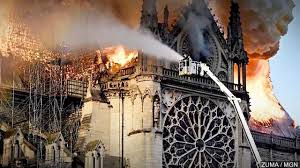
Notably, the cathedral was undergoing renovation work and the fire broke out around 7 p.m.
People were shocked by the event especially with the upcoming Easter celebrations and were in awe at the site of the gradual destruction of the spire.

According to the CBS News, two-thirds of the roof has been destroyed but luckily the iconic flying buttresses which are over a 1000 years old have survived the flareups.
Another survivor, the Great Organ one of the largest in the world stays intact in the main Cathedral which is good news.
Many valuable artifacts have been procured including the Crown of Thorns. But, portions of the vaulted ceiling has collapsed due to the fire.
Apart from this, the tunic of King St. Louis has been procured and saved on Monday.

The True Cross where Jesus was crucified and one of the original nails have also been secured from the flames.
The Rose Windows remains intact and has not been harmed by the fire. Although, it will be inspected later for hidden damages.
Unfortunately, three relics namely a part of the Crown of Thorns, a relic of St. Denis and that of St. Genevieve has been destroyed and could not be found.
Many sculptures and artwork have been moved to the Paris Town Hall and Louver Museum for safekeeping.
The notable statue of Madonna and Child and the sculpture of Nicolas Coustou is unharmed.
The people of France are praying for the revival of their favorite house of worship. Hundred gathered around the cathedral singing “Ave Maria” with tears in their eyes unable to believe their faith crumbling down.

Churches rang bells in support of Notre Dame and praising the heroic deeds of firefighters and devotees who gathered around to save the valuables of the church.
Notre de Dame will undeniably remain in the hearts of millions of devotees worldwide.
We can just hope that it will soon be revived to its former glory and will reopen to its innumerable devotees worldwide.
